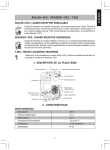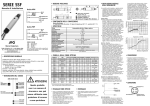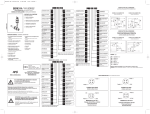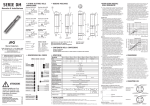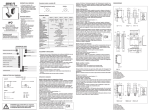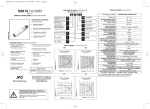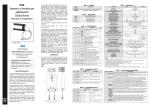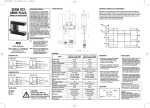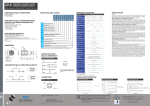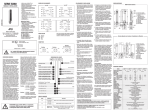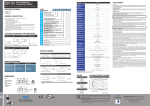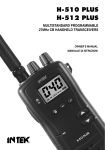Download SERIE BX - Sensor Centre
Transcript
emitter without adjustment receiver emitter/receiver pair Specific applications Wood industry: way in of wood tables with irregular profiles Wood industry: detection of a long board (even in the presence of vibrations) coming out from a rolling machine Metal processing: control of sheets coming out from rolling machines (even in the presence of vibrations) Control of output material presence Strada S.Caterina, 235 - 41100 Modena Italy Tel. +39 059 420411 Fax +39 059 253973 www.microdetectors.com [email protected] Detection of object presence on the conveyor belt Counting of objects being unloaded S 0 emitter E R SR D Two independent outputs PNP and NPN, both in the same state. 20 244 199 27 11.5 14 3 Output state 0 0 emitter with Check function option. X dark-pulse receiver (NO, normally open) A light-pulse receiver(NC, normally closed, C not standard) receiver with NO/NC selection (not standard) 22 12 emitter 1.5 M12x1 Ch.13 M18x1 x Pg 7 Ω5 • SUPPLIED MATERIAL Installation Manual Sensor / Sensors depending by code N. 1. bracket ST18-C for each element N. 1. M18 metal fastening ring nut for each element. Trimmer adjustment accessori ST82 422 20 Axial cable exit M12 metal plug cable exit Sensitivity adjustment Yellow LED Red LED Mounting bracket ST18-C • SPECIFICATIONS • GENERAL DESCRIPTION New generation of multiple beam photoelectric area sensors for detecting the presence or passage of objects; no wiring synchronism between emitter and receiver is required. The new housing, rectangular and extremely compact, is manufactured through the injection moulding technique. The use of fibreglass-strengthened plastic together with walls of substantial thickness, make the housing extremely strong and suitable for use in industrial environments. The protection degree is IP67. These sensors' operation is based on the total beam crossing principle: the emitter photodiodes are switched on one at a time in sequence and the light given out by each emitter must be seen simultaneously by all of the receiver photodiodes. The height of the area checked is 90 mm, irrespective of the number of beams (whether 4 or 10). The light from the emitter is modulated to minimize sensitivity of the system to ambient light. The product features a nominal sensing range of 2000mm and a minimum range of 300mm (blind zone); all models have a 90mm high optical lens, the 10-beam version has a 10mm optical element spacing, which is 30mm for the 4beam version. The Light-dark response time is maximum 1ms, the minimum duration of the dark pulse is 5ms, extendable to 80ms in the special models with delay off. The Output type 7.2 9 23 Materials handling: detection of differently sized or irregularly shaped objects Element 5 IP 67 protection degree emitter with sensitivity adjustment A PG7cable exit, M18 thread available for fastening with bracket ST18-A or C. 14.7 10 H 1.1 Ω 4.2 120 ten optical elements, 10mm element spacing, area height 90mm M12 plug, M18 thread available for fastening with bracket ST18-A or C. 44 5 04 20 110 four optical elements, 30mm element spacing, area height 90mm electrical damages. Extremely strong housing. 144 R 16.5 Output connection Type 90 Complete protection against B BX 4 Sensing range up to 2m Ghiera M18x1 3 area sensor in rectangular plastic housing 20x45x120mm Range 0.3 - 2 m sensing range MODEL emitter has only one green LED indicating emission which, in the version with the check function, switches off when the check mode is active. The receiver has two LEDs, one yellow and one red. The brightness of the red LED is inversely proportional to the level of the signal; the LED switches off when the signal is sufficient and it does not indicate excess gain. The yellow LED lit indicates that the output is ON. The receiver features two available outputs, PNP and NPN. The dark-pulse/light-pulse selection function is available. Emitter with or without check function are available. The emitter power can be adjusted by means of the trimmer. The main applications are implemented placing emitter and receiver at opposite sides of a conveyor belt and orientating them perpendicularly to the motion direction. Depending on the different requirements and on the objects to be detected, the controlled area can lie entirely above the belt conveying surface, or it can be half above and half below the said surface. In this last case, the BX pair is positioned at an interruption in the belt, at the end or at the separation point between two adjacent belts. The sensor thickness of only 20mm is particularly suitable for applications of the latter type. Type Nom. Sensing Distance (Sn) Emission Controlled Area Height Operatine Distance Minimum Detectable Object Differential Travel Operating Voltage Ripple No-load Supply Current Load Current Leakage Current Voltage Drop Output Type Response Time (Light/Dark) Response Time (Dark/Light) Time Delay Before Availability Supply Electrical Protections Output Electrical Protections Temperature Range Interferece to External Light Protection Degree LED Indicator (emitter) LED Indicator (receiver) Housing Material Lenses Material Tightening Torque Weight (approx.) (1) BX04/**-** Guaranteed resolution everywhere in the detection area Guaranteed resolution in the central part of the detection area with exclusion of the dark zones As note (2), but with sensivity adjustment (4) NC output models available on request Dark zones are parts of the detection area close to the emitter and the receiver, their amplitude X is proportional to the distance D between the emitter and the receiver. (2) (3) BX10/**-** Medium Resolution Area Sensor 2m Infrared (880nm) modulated 90mm 2m φ35(1) / φ25(2) / φ15(3) mm φ15(1) / φ7.5(2) / φ5(3) mm <10% 10 – 26 Vdc 10% 50 mA (emitter) – 25 mA (receiver) 100 mA < 10 µA (at VDC max.) 2 V at 100 mA NPN + PNP – NO Standard(4) 500 µs 5 ms 100 ms Polarity Reversal, Transient Short Circuit (autoreset) -5 /+ 55 °C (without freeze) 1000 lux (incandescent lamp) – 1500 lux (sunlight) IP67 (EN60529) Green (power and emission) Red (alarm) – Yellow (output state) Valox PC 25 Nm 260…300 (plug) - 800g (cable) BX04: X=0.17D BX10: X=0.06D Connections 1) Make sure that the operating voltage is correctly stabilized with a maximum ripple lower than that given in the catalogue. 2) In the event that the noise induced by the power lines is greater than that foreseen by the EMC regulation (interference immunity), detach the sensor cables from the power and high voltage lines and insert the cable in an earthed metal cable trough. Furthermore, it is advisable to connect the sensor directly to the supply source and not downstream other devices. 3) To extend the supply and output cables use a cable featuring wires with a minimum crosssection of 1mm2. The extension limit in length is 100m (with respect to a minimum voltage and load current of 100mA). 4) The sensor state will be active only 100ms after voltage has been supplied. During this time, the outputs will be OFF. Mounting 1) The use of the brackets ST18-C is advised for a perfect mounting and alignment. 2) Do not allow dust, water and condensation to deposit on the element optics. 3) Avoid exposing the optics to chemical reactive products 4) Do not allow strong light or sunlight to fall directly onto the receiver optical element. 5) For cleaning, use a wet cloth and then dry all parts. Alignment / Adjustment 1) Check that the distance between the emitter and the receiver falls within the specification range of the model used. Arrange the brackets so that the displacement between the axes of the two parts (emitter and receiver) lies within ±1,5°. 2) Position the optical lenses facing one other, aligning them as much as possible with the axis joining the two parts. 3) Check the wiring and supply power to the system. The green LED on the emitter switches on (check also that, in the emitters, the sensitivity adjustment trimmer is rotated in a clockwise direction to the final position). 4) Rotate the emitter checking the receiver's red LED and searching the minimum brightness position or switching-off; secure it provisionally in this position. 5) Rotate the receiver checking its red LED and searching the minimum brightness position or switching-off; secure it provisionally in this position. 6) Repeat points 4 and 5 until the red LED on the receiver switches off. 7) If it is not possible to switch off the receiver's red LED, check the relative height, parallelism and distance between the two elements, and try to improve the conditions referring to the minimum brightness of the LED. Points 8 to 10 are used to obtain the highest possible signal margin, which is useful in the case of demanding working conditions. 8) Rotate the trimmer on the emitter in an anticlockwise direction, until the receiver's red LED switches on with a medium-low brightness. 9) Orientate the emitter and the receiver as described in points 4 and 5, so as to find the minimum brightness area or switching-off. 10) Repeat points 8 and 9 so as to improve the beam aiming, then bring the trimmer back to its (threshold) position. 11) To detect small object , rotate the trimmer in a clockwise direction a few degrees beyond the point at which the red LED switches off. 12) Check the detection of the required diameters and secure the system. N.B. The trimmer adjustment is indispensable for obtaining a maximum resolution, above all in the event that emitter and receiver are positioned at a distance lower than the nominal one, or in the detection of semitransparent objects. Very small diameters cannot be detected regularly in proximity of the optical elements, but are detected in the central zone, this being the maximum resolution area. The dark zone within which such diameters cannot be detected, can be obtained from the figure below and from the previously described formulas. The dimension of the blind zone is found using the following formula: x = 0,06 * d 10-optics sensor x = 0,17 * d 4-optics sensor • WIRING DIAGRAMS EMITTER CONNECTIONS RECEIVER CONNECTIONS BN 1 + BN 1 + BU 3 - BU 3 BK 4 BK 4 pnp out WH 2 WH 2 npn out check check + Model BX**S/XO -** WIRING 1/Bn : 2/Wh : 3/Blu : 4/Blk : Model BX**R/*D-**** COLORS Brown White Blue Black • DIAGNOSTIC LED STATUS CONDITION GREEN emitter SUPPLY ON Supply YELLOW receiver ON OUTPUT OFF RED receiver ALIGNMENT ON state output OFF state output BRIGHT ON LESS BRIGHT ON OFF No alignment Partial alignment or low received signal Good alignment and enough received signal • CONNECTORS Check (-) Supply (-) 4 3 1 2 Supply (+) Check (+) • EMITTER (OUT PNP) Supply (+) Supply (-) 4 3 1 2 (OUT NPN) • RECEIVER WARNING These products are NOT safety sensors and are NOT suitable for use in personal safety application CAT8BBX0214702 Staffa dis. 2628 and check input on request. Controlled area hight up to 90 mm • INSTALLATION AND ADJUSTMENT PROCEDURES BX 04 S / 0 0 - H B Series Emitter with power adjustment • MECHANICAL DRAWINGS 20 Installation manual • CODE DESCRIPTION ~18.5 SERIE BX MINIATURE DC AREA SENSOR WITH 4 OR 10 OPTICAL ELEMENTS IN A RECTANGULAR HOUSING Elemento Tipo d’uscita danneggiamenti di tipo elettrico emettitore con regolatore di sensibilità S 0 Contenitore di grande robustezza emettitore senza regolazione E R SR coppia emettitore/ricevitore Macchine per legno : Rilevazione di una tavola (anche con vibrazioni) in uscita da rulliere www.microdetectors.com [email protected] Controllo presenza materiale in uscita Rilevazione di presenza oggetti su nastro trasportatore Conteggio di particolari in caduta. 20 244 199 14.7 Due uscite indipendenti 27 11.5 C emettitore con possibilità di Check 3 5 12 ricevitore impulso luce (NC, normalmente chiuso, non standard) ricevitore con selezione NA/NC (non standard) 23 ricevitore impulso buio (NA, normalmente aperto) 0 0 X A emettitore 14 1.5 M12x1 Ch.13 M18x1 x Pg 7 Ω5 • CONTENUTO DELLA CONFEZIONE Manuale di installazione Sensore / Sensori dipendentemente dal codice N. 1. staffa ST18-C per ogni elemento N. 1. ghiera metallicha M18 per ogni elemento Accessorio di regolazione trimmer ST82 422 20 Uscita cavo assiale Uscita connettore M12 metallico Regolazione sensibilità LED giallo LED rosso Staffa di fissaggio ST18-C • SPECIFICHE • DESCRIZIONE GENERALE Nuova generazione di sensori fotoelettrici di area a raggi multipli, per intercettazione di presenza o passaggio di oggetti che non necessita di un sincronismo cablato fra proiettore e ricevitore. Il nuovo contenitore, di forma parallelepipeda e di dimensioni estremamente compatte, è ottenuto per stampaggio a iniezione. L’uso di plastica caricata con fibre di vetro abbinato a pareti di grande spessore, lo rendono estremamente robusto e adatto all’impiego in ambienti industriali. La protezione è IP67. Il principio di funzionamento è quello dell’intreccio totale: i LED dell'emettitore sono accesi uno alla volta in sequenza e la luce emessa da ciascun emettitore deve essere vista contemporaneamente da tutti i fotododi del ricevitore. L’altezza dell’area controllata è di 90mm, indipendentemente dal numero dei raggi (siano 4 o 10). L’emissione è modulata per minimizzare la sensibilità del sistema alla luce ambiente. Il prodotto presenta portata nominale pari a 2000 mm , portata minima (zona cieca) pari a 300mm , altezza della finestra ottica 90mm per tutti i modelli, passo ottiche 10mm per la versione a 10 raggi, 30mm per la versione a 4 raggi. Il tempo di risposta luce/buio è massimo 1ms, la durata minima dell’impulso buio è 5ms, allungabile a 80ms nei modelli speciali con delay off. L’emettitore ha un solo LED verde indicante 7.2 nello D PNP ed NPN, ambedue stesso stato. Stato uscita Lavorazione metalli: controllo di lamiere sottili in uscita da rulli anche con vibrazioni Strada S.Caterina, 235 - 41100 Modena Italy Tel. +39 059 420411 Fax +39 059 253973 emettitore 9 Applicazioni tipiche Macchine per legno : Ingresso di tavole in legno con profilo variabile A Passacavo PG7, filetto M18 disponibile per fissaggio con staffa ST18-A o C 22 ricevitore H 120 10 1.1 Ω 4.2 5 dieci ottiche passo 10 mm, altezza area 90 mm connettore M12, filetto M18 disponibile per fissaggio con staffa ST18-A o C 44 110 04 20 90 quattro ottiche passo 30 mm, altezza area 90 mm Totalmente protetti contro Movimentazione : controllo presenza oggetti in posizioni non ripetibili e/o di forme variabili o irregolari 144 R 16.5 Attacco d’uscita Tipo Distanza di lavoro nominale 2 m. Grado di protezione IP67 4 Controllo di aree di altezza 90mm. B BX 3 sensore di area in contenitore plastico rettangolare 20x45x120mm Ghiera M18x1 Portata portata 0.3 - 2 m MODELLO l’emissione, che nella versione con check si spegne quando il check è attivo. Il ricevitore presenta due LED uno giallo e uno rosso. Il led rosso si illumina in modo proporzionale all’inverso del livello del segnale ed è spento quando il segnale è sufficiente. Il LED non indica l’eccesso di guadagno. Il LED giallo acceso indica che l’uscita è ON. Il ricevitore rende disponibili due uscite PNP ed NPN. E’ disponibile la funzione impulso-buio impulso-luce selezionabile. Disponibile emettitore con o senza funzione di check. E’ disponibile nell’emettitore la possibilità di regolare la potenza emessa mediante trimmer. Le applicazioni principali sono realizzate, ponendo proiettore e ricevitore ai lati opposti di un nastro trasportatore con orientamento perpendicolare al senso di moto. A seconda delle necessità e degli oggetti da intercettare, l’area sensibile può essere tutta al di sopra del piano di trasporto del nastro, oppure può essere per metà al di sopra e per metà al di sotto del piano di trasporto, in questo ultimo caso la coppia di BX sarà posizionata in corrispondenza di una interruzione del nastro,alla fine dello stesso, o nel punto di separazione tra due nastri affiancati. Lo spessore di soli 20mm del sensore favorisce le applicazioni di questo ultimo tipo. Tipo Distanza di lavoro nominale Emissione Altezza area sensibile Distanza di lavoro Oggetto minimo rilevabile Corsa differenziale Tensione di alimentazione Ondulazione residua Corrente assorbita Corrente di uscita Corrente di perdita Caduta tensione in uscita Tipo uscita Tempo di risposta ( Luce/buio) Tempo di risposta (buio/luce) Ritardo alla disponibilità Protezioni elettriche alimentazione Protezioni elettriche uscita Limiti di temperatura Interferenza alla luce esterna Grado di protezione Indicatori LED ( emettitore) Indicatori LED ( ricevitore) Materiale contenitore Materiale ottiche Coppia serraggio Peso (approssimativo) (1) BX04/**-** Risoluzione garantita in qualsiasi punto dell’area Risoluzione garantita nella parte centrale dell’area escludendo le zone buie Come nota (2), ma utilizzando la regolazione di sensibilità (4) Modelli con uscita NC disponibili a richiesta Le zone buie corrispondono a parti dell’area adiacenti agli elementi proiettore e ricevitore, hanno una ampiezza X proporzionale alla distanza D tra proiettore e ricevitore. (2) (3) BX10/**-** Sensore di area a media risoluzione 2m Infrarosso (880nm) modulato 90mm 2m φ35(1) / φ25(2) / φ15(3) mm φ15(1) / φ7.5(2) / φ5(3) mm <10% 10 – 26 Vdc 10% 50 mA (emettitore) – 25 mA (ricevitore) 100 mA < 10 µA (at VDC max.) 2 V at 100 mA NPN + PNP – NO Standard(4) 500 µs 5 ms 100 ms Inversione di polarità , sovratensioni impulsive Cortocircuito (autoripristinante) -5 /+ 55 °C (senza condensa) 1000 lux (lampada ad incandescenza) – 1500 lux (Luce solare) IP67 (EN60529) Verde ( emissione abilitata) Rosso (margine di segnale) – Giallo (stato uscita) Valox PC 25 Nm 260…300 (connettore) 800g (cavo) BX04: X=0.17D BX10: X=0.06D Connessioni 1) Assicurarsi che la tensione di alimentazione sia correttamente stabilizzata con una ondulazione residua massima inferiore ai dati di catalogo. 2) Nel caso che il rumore indotto dalle linee di potenza risulti superiore a quello previsto dalla normativa CE (immunità ai disturbi), separare i cavi del sensore dalle linee di potenza e di alta tensione e inserire il cavo in una canalina metallica connessa a terra. E’ consigliabile inoltre, collegare il sensore direttamente alla sorgente di alimentazione e non a valle di altri dispositivi. 3) Per estendere i cavi di alimentazione e uscita utilizzare un cavo avente conduttori di sezione minima di 1mm2. Il limite dell’estensione in lunghezza è 100m (riferiti a tensione minima e corrente al carico di 100mA). 4) Lo stato del sensore diventa valido solo dopo 100ms dalla fornitura di alimentazione. In questo periodo le uscite saranno OFF. Montaggio 1) Si consiglia l’uso della staffe ST18-C per un perfetto montaggio ed allineamento. 2) Evitare il deposito di materiali come polvere, acqua, condensa, sull’ottica degli elementi. 3) Evitare l’esposizione dell’ottica a prodotti chimici aggressivi. 4) Evitare che una luce forte o la luce solare incidano direttamente sull’ottica del ricevitore. 5) Per la pulizia usare un panno umido e asciugare. Allineamento / Regolazione 1) Verificare che la distanza tra emettitore e ricevitore sia compresa nei limiti di specifica del modello utilizzato. Predisporre lo staffaggio in modo che il disassamento tra gli assi dei due elementi (emettitore e ricevitore) risulti compreso tra ±1,5°. 2) Posizionare le finestre delle ottiche una affacciata all’altra il più possibile corrispondenti all’asse di congiunzione dei due elementi. 3) Verificare il cablaggio ed alimentare il sistema. Il LED verde sull’emettitore si accende (verificare inoltre che negli emettitori il trimmer di regolazione della sensibilità sia ruotato nell’estrema posizione in senso orario). 4) Ruotare l’emettitore osservando il LED rosso del ricevitore ricercando la posizione di minima luminosità o spegnimento e fissarlo provvisoriamente in queste condizioni. 5) Ruotare il ricevitore osservando il LED rosso dello stesso ricercando la posizione di minima luminosità o spegnimento e fissarlo provvisoriamente in queste condizioni. 6) Ripetere i punti 4 e 5 fino allo spegnimento del LED rosso sul ricevitore 7) Nel caso non sia possibile ottenere lo spegnimento del LED rosso del ricevitore verificare altezza relativa, parallelismo, distanza dei due elementi e cercare di migliorare le condizioni facendo riferimento alla minima luminosità dello stesso.I punti da 8 a 10 servono per ricavare il margine di segnale più alto possibile, utile in condizioni gravose di lavoro. 8) Ruotare il trimmer sull’emettitore in senso antiorario fino ad ottenere l’accensione del LED rosso del ricevitore ad una luminosità medio-bassa. 9) Orientare l’emettitore ed il ricevitore come ai punti 4 e 5 in modo da ricercare la zona di minima luminosità o spegnimento. 10) Ripetere i punti 8 e 9 in modo da migliorare l’orientamento poi riportare al massimo il trimmer. 11)Per rilevare piccoli oggetti ruotare il trimmer in senso orario di alcuni gradi oltre il punto per cui si ottiene lo spegnimento del Led rosso . 12)Verificare l’ottenimento della rilevazione degli oggetti desiderati e fissare il sistema. N.B. La regolazione del trimmer è indispensabile qualora si desideri ottenere la massima risoluzione, soprattutto nei casi in cui emettitore e ricevitore siano posizionati a distanze inferiori a quella nominale o nella rilevazione di oggetti semitrasparenti. Diametri molto piccoli non possono essere rilevati con continuità in prossimità delle ottiche , ma vengono rilevati nella zona centrale , essendo questa la zona di massima risoluzione . La zona buia entro la quale tali diametri non possono essere rilevati può essere ricavata dalla figura sottostante e dalle formule precedentemente presentate. La dimensione della zona cieca X viene fornita dalla seguente formula: x = 0,06 * d sensore a 10 ottiche x = 0,17 * d sensore a 4 ottiche • CONNESSIONI EMETTITORE CONNESSIONI RICEVITORE CONNESSIONI BN 1 + BN 1 BU 3 - BU 3 BK 4 BK 4 pnp uscita WH 2 WH 2 npn uscita check check + Modello BX**S/XO-** CODICE 1/Bn : 2/Wh : 3/Blu : 4/Blk : + Modello BX**R/*D-**** COLORI Brown/Marrone White/Bianco Blue/Blu Black/Nero • DIAGNOSTICA LED STATO CONDIZIONE VERDE emettitore ACCESO SUPPLY Alimentazione presente e stabile GIALLO ricevitore ACCESO OUTPUT SPENTO Uscita in stato ON Uscita in stato OFF ROSSO ricevitore ALLINEAMENTO ACCESO intenso ACCESO tenue SPENTO Nessun allineamento Allineamento parziale o scarso segnale ricevuto Allineamento corretto e segnale sufficiente • CONNETTORI Check (-) Alimentazione (-) 4 3 1 2 Alimentazione (+) Check (+) • EMETTITORE (USCITA PNP) Alimentazione (+) Alimentazione (-) 4 3 1 2 (USCITA NPN) • RICEVITORE ATTENZIONE Questo prodotto non è un sensore di sicurezza e non può essere utilizzato come protezione di accesso a zone pericolose. CAT8BBX0214702 Staffa dis. 2628 portata a mezzo trimmer, ed ingresso di check su richiesta. • PROCEDURE DI INSTALLAZIONE E REGOLAZIONE BX 04 S / 0 0 - H B Serie Emettitore con regolazione di • DISEGNI MECCANICI 20 Manuale di installazione • DESCRIZIONE DEL CODICE ~18.5 SERIE BX SENSORE DI AREA A 4 O 10 OTTICHE MINIATURIZZATO DC IN CONTENITORE PARALLELEPIPEDO


